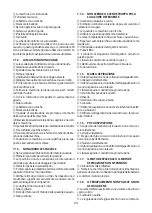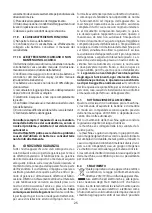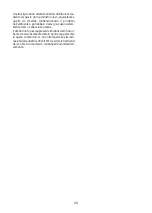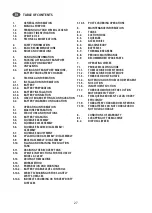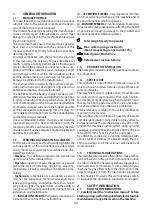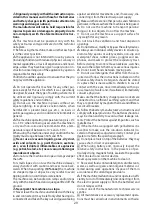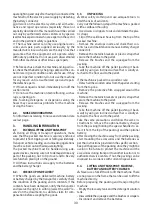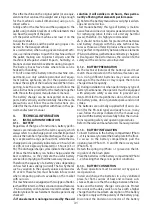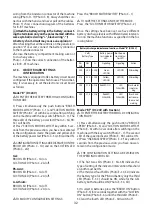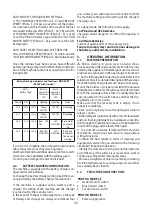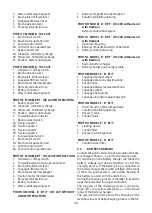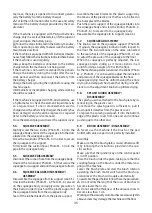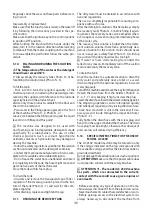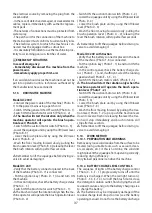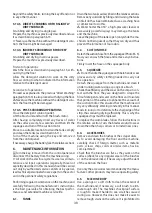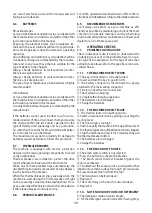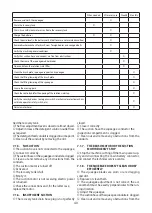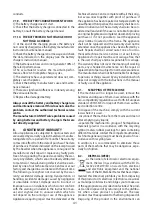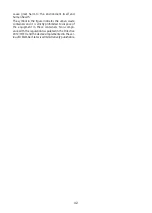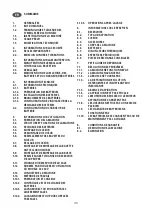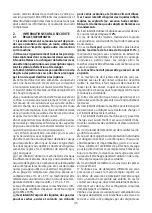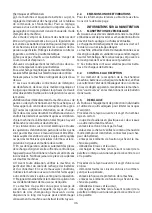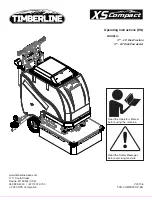
38
beyond the safety limits, turning the key off and on or
in any other manner.
5.14.3. DIRECT SCRUBBING OR FOR SLIGHTLY
DIRTY SURFACES
Scrubbing and drying in a single pass.
Prepare the machine as previously described and use
it as described in paragraph 6.13.
☞
Never use the machine without the detergent solu-
tion: the floor might be damaged.
5.14.4. INDIRECT SCRUBBING OR FOR VERY
DIRTY SURFACES
Scrubbing and drying in various passes.
Prepare the machine as previously described.
First set of operations:
Wash the floor as described in paragraph 6.13, with-
out drying the floor
Allow the detergent solution to work on the dirty
floor according to what is indicated in the information
relative to the detergent used.
Second set of operations:
Proceed as explained in the previous “Direct Washing”
paragraph (6.14.3) to also proceed with drying the floor.
•
Never use the machine without the detergent solu-
tion: the floor might be damaged.
5.14.5. POST-SCRUBBING OPERATIONS
Close the detergent solution outlet.
Lift the brush unit and turn off the brush motor.
After having completely dried any traces of water
on the surface, wait a few seconds and then lift the
squeegee and turn off the suction motor.
Move to a suitable location to drain the tanks; empty
and clean the tanks (as described in 6.11).
Turn off the machine using the key and remove it
from the control panel.
If necessary, charge the battery (see the relative section).
6.
MAINTENANCE INFORMATION
•
Turn the key, remove it from the control panel and
disconnect the battery from the machine wiring.
☞
All work on the electrical system as well as all main-
tenance and repair operations (especially those not
explicitly described in this manual) should be carried
out only by authorized service centers or by special-
ized technical personnel who are experts in the sector
and in the pertinent safety regulations.
Performing regular maintenance on the machine, and
carefully following the manufacturer’s instructions,
is the best guarantee for obtaining the best perfor-
mances and extended machine service life.
6.1.
TANKS
Drain the two tanks as described in the relative sections.
Remove any solid dirt by filling and draining the tanks
until all dirt has been eliminated: use a washing hose
or similar tool to do this.
•
Water hotter than 50°, a high-pressure cleaner or
excessively powerful sprays may damage the tanks
and the machine.
Leave the plugs of the tanks open (only while the ma-
chine is not being used) so that they can dry and thus
prevent the formation of foul odors.
6.2.
SUCTION HOSE
Detach the suction hose from the squeegee ( Photo M - 3).
Now you can wash the hose and remove any obstruc-
tions.
Firmly insert the hose on the squeegee body.
6.3.
SQUEEGEE
•
Do not handle the squeegee with bare hands: wear
gloves and any safety clothing needed to carry out
the operation.
Detach the squeegee from the machine and clean it
under running water using a sponge or a brush.
Check the efficiency and the wear on the strips in con-
tact with the floor. They are designed to scrape the
film of detergent and water on the floor and to isolate
that portion of the surface to enhance the vacuum of
the suction motor: this ensures that the machine will
dry very efficiently. Working constantly in this manner
tends to round or to deteriorate the sharp edge of the
strip, thus reducing drying efficiently. This is why the
squeegee strips must be replaced.
To replace the worn blades, follow the instructions in
the relative section. Turn the blades around to wear
down the other sharp corners or to install new ones.
6.4.
ACCESSORIES
Remove and clean the brushes or the scraper disks.
•
To avoid damaging the floor and the machine,
carefully check if foreign matter, such as metallic
parts, screws, chips, cords or similar items, has be-
come jammed.
Check that the brushes are flat as they work on the
surface (check for any irregular wear on the brushes
or on the abrasive disks). If necessary, adjust the slant
of the action on the floor.
Use only the accessories recommended by the manu-
facturer: other products may reduce operating safety.
6.5.
MACHINE BODY
Use a sponge or a soft cloth to clean the exterior of
the machine and, if necessary, a soft brush to elim-
inate tough dirt. The machine’s shockproof surface
is rough to make it harder to see scratches caused
during use. However, this does not make it easier to
remove tough stains on the surface. It is prohibited to
Summary of Contents for Clean Track NANOscrub Evo 50 cbt
Page 3: ...3 2 1 3 A B 6 1 3 4 5 2 E AC 230V...
Page 4: ...4 C D 2 2A 3A 3B 3C 1A 1 3 6 3 4 5 1 8 2 B DC 24V 7...
Page 6: ...6 H G 1 2 1 3 2 I...
Page 7: ...7 1 2 L M 1 1 4 4 3 2 5 7 6 5 2 6...
Page 8: ...8 N O 1 1 2 3 3 2 4...
Page 9: ...9 P 1...
Page 95: ...95 1 1 1 1 2 2 10 1 3 1 4...
Page 96: ...96 1 5 2 2 1 4 35 10 50 30 95 2 10...
Page 97: ...97 2 2...
Page 98: ...98 3 3 1 3 2 3 3 C C 3 4...
Page 99: ...99 4 4 1 4 1 1 20 20 20h 5 5 5h 5 5 20 20 24 4 1 2 4 1 3 I 2 G 1 3 I 1 I 2...
Page 104: ...104 5 4 M 6 M 6 M 3 5 5 M 6 5 6 6 5 M 4 M 6 M 4 M 6 6 4 5 7 M 2 45 M 2 M 7 5 8 5 9...
Page 105: ...105 1 1 5 10 50 C 3 4 2 2 2 P 1 5 11 3 1...
Page 106: ...106 5 D 6 F 7 3 5 12 AC 230V AC230 AC 230V 5 13 230V 1 1 ON 2 B 5 A 3 3 2 4 DC 24V D 7 D 1 3 1...
Page 108: ...108 5 14 5 6 11 6 6 1 50 6 2 M 3 6 3 6 4 6 5 6 6...
Page 109: ...109 6 7 6 8 6 8 1 6 8 2 6 8 3 6 9...
Page 110: ...110 7 7 1 7 1 1 1 C 7 1 2 5 7 1 3 7 1 4 7 1 5 7 1 6 7 1 7 7 1 8...
Page 111: ...111 7 1 9 7 1 10 100 20 30 8 12 8 1 2013 56 EU 8 2...
Page 112: ...112 2012 19 EU 2012 19 EU...
Page 130: ...130 8...
Page 131: ...131 7 3 12...
Page 132: ...132 6...
Page 133: ...133 5 2 10...
Page 134: ...134 4 4 35 10 50 30 95...
Page 135: ...135 3 5 1 CE CE 2 1 2...
Page 136: ...136 2 3 1 CE 4 1...
Page 137: ...137 1 1 1 1 1 2...
Page 246: ...246 1 1 1 1 2 2 10 1 3 a 1 4...
Page 247: ...247 1 5 2 2 1 4 C 35 C 10 C 50 C 30 95 2 10...
Page 248: ...248 2 2 3 3 1 3 2 3 3...
Page 249: ...249 3 4 4 4 1 Ah 20 C20 20h 5 C5 5h C5 C20...
Page 254: ...254 1 Pb Pb 5 4 M 6 6 M 3 5 5 6 5 6 6 5 M 4 M 6 M 4 M 6 6 4 5 7 M 7 2 45 M 2 M 7 5 8...
Page 255: ...255 5 9 OFF 1 cm 1 cm OFF 5 10 L 50 C N 4 N 3 2 N 2 2 L Q 1 5 11 N 3 0 1...
Page 258: ...6 11 6 258 6 1 50 X X X X X X X X X X X X X X X X X X...
Page 259: ...259 6 2 3 6 3 6 4 6 5 6 6 BPb 3 AGM 6 6 7...
Page 260: ...260 6 8 6 9 7 7 1 7 1 1 ON 7 1 2 5 7 1 3 7 1 4 7 1 5 7 1 6 7 1 7...
Page 261: ...261 7 1 8 7 1 9 7 1 10 100 20 30 8 12 8 1 2013 56...
Page 262: ...262 8 2 WEEE 2012 19 2012 19 EU...
Page 264: ...264 1 1 1 1 2 2 2 10 1 3 1 4...
Page 265: ...265 1 5 2 2 1 4 C 35 C 10 C 50 C 30 95 2 10...
Page 266: ...266 2 2 134 3 3 1 3 2 3 3...
Page 267: ...267 3 4 4 4 1 4 1 1 Ah 20 C20 20h 5 C5 5h C5 C20...
Page 273: ...273 5 8 5 9 1 cm 1 cm 5 10 50 C N 4 N 3 G 2 N 2 2 cm 5 11...
Page 276: ...6 13 6 14 3 5 14 5 276 6 11 6 X X X X X X X X X X X X X X X X X X...
Page 277: ...277 6 1 50 6 2 M 3 6 3 6 4 6 5 6 6...
Page 278: ...278 3 AGM 6 6 7 6 8 6 9 7 7 1 7 1 1 1 30 7 1 2 5 7 1 3...
Page 279: ...279 7 1 4 7 1 5 7 1 6 7 1 7 7 1 8 7 1 9 7 1 10 100 20 30...
Page 280: ...280 8 12 8 1 2013 56 E 8 2 2012 19 2012 19...
Page 284: ...7 504 0357 rev 01 01 2022...

